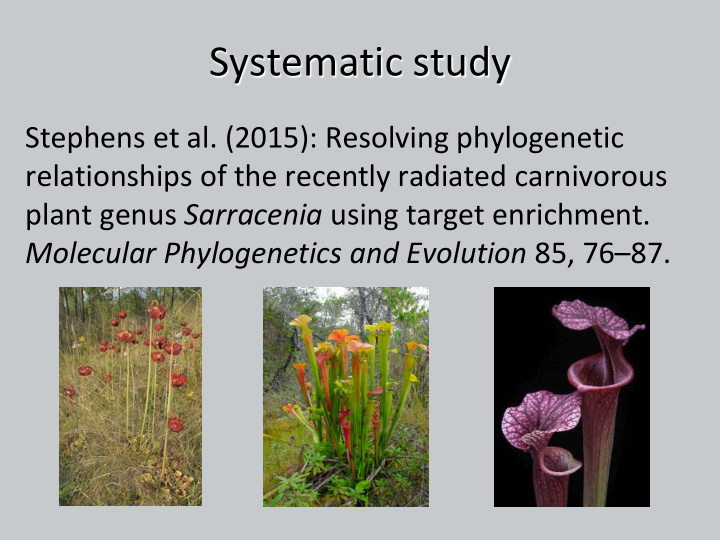



Systematic study Stephens et al. (2015): Resolving phylogenetic relationships of the recently radiated carnivorous plant genus Sarracenia using target enrichment. Molecular Phylogenetics and Evolution 85, 76–87.
Reasons for the study • elucidate evolutionary relationships of Sarracenia (New World pitcher plants) • Sarracenia – recently diverged group • previous attempts at construction phylogeny failed • assess the utility of target enrichment of nuclear genes for a recently radiated, non- model genus
Study genus – Sarracenia • 8-11 species • 41 subspecies, varieties and forms • wet savannas and fens of N America • endangered – due to destroyed habitats (less than 3% remained) • recently radiated (0.5-3 million years ago) • Heliamphora – sister genus • Darlingtonia – basal lineage in Sarraceniaceae
Methods – probes, libraries • 71 accessions • probe design – comparing two Sarracenia transcriptomes – ca. 1, 000 contigs • within-species BLAST – search for potential paralogues • reciprocal best BLAST (blastn) – determine othologues between species • resulted in 646 genes for target enrichment • DNA sheared to fragments (180-500 bp) • Illumina TruSeqHT compatible libraries • target enrichment using MYbaits • sequenced on Illumina HiSeq PE100
Methods – read analysis • quality check – FastQC • quality trimming – FastX Toolkit • Illumina adapter removal – FAR • assembly – two approaches • de novo – Trinity • reference-based – Columbus extension module in VELVET • identical contigs merged (CAP3) and matched against gene targets (BLAST) – 1:1 hits retained • contigs merged, aligned (Prank), poorly aligned regions removed (Gblocks) • selection of loci with • less than 0.35 average pairwise distance • at least 50% of the accessions present • no more than 45% of missing data • at least one outgroup
Methods – tree analyses • gene trees – ML in RAxML, 500 bootstrap replicates • MP-EST species tree • STEM-hy – test hypotheses of hybrid species (on taxa showed incongruence between MP-EST and concatenated trees) • concatenated analysis – RAxML, 1000 bootstrap replicates • plastome tree • reads mapped to Vitis plastome (Bowtie2), extracted (SAMtools), assembled with YASRA (reference-based assembler) • contigs concatenated • aligned using MAFFT, poorly aligned regions removed (Gblocks) • ML tree (RAxML, 1000 bootstrap replicates)
Results • each accession – roughly 3.5 million reads • 7,124 Trinity and 67,894 Velvet contigs – merged into 5,608 contigs per assembly • 546 contigs matched 646 genes • 11× coverage • 199 genes – average length 642 bp, 128,110 bp in total • 8.7% variable characters • 4% parsimony informative characters • plastome – 42,031 bp • 1.9% variable characters • 0.5% parsimony informative characters
Results • MP-EST – supports monophyly of Sarracenia , many relationships within the genus • rubra complex – polyphyletic • flava , minor , psittacina , purpurea monophyletic • concatenated tree – similar topology, but • purpurea sister to oreophila • flava sister to minor and psittacina • plastid tree – very low resolution • jonesii and purpurea subsp. venosa var. montana – one clade, indication for introgression • minor , psittacina and purpurea – hybridization between sister taxa not supported by STEM-hy
Discussion • difficulties of inferring phylogenies of recently radiated groups • MP-EST and concatenation – only few conflicts • robust taxon sampling • lack of “anomaly zone” (i.e., highly probable gene topology that conflicts with the species tree) • two major conflicts – placement of the purpurea complex and psittacina – no dominant topology among gene trees • conflict between nuclear and plastid tree – supports the role of hybridization and ILS – common in recently radiated groups
Discussion - biogeography • diversification of Sarracenia – less than 3 mya • two species growing on ancient Appalachian soils ( oreophila and purpurea ssp. venosa var. montana ) are basal to other species – common ancestor in southern Appalachian massif • first scenario • ancestors of two subclades migrated into the Gulf and Atlantic • purpurea / minor clade – to Atlantic Coastal Plain • oreophila ancestor – ACF river drainage to the Gulf Coastal Plain • second scenario • diversification around the Appalachian region – here is the highest overlap of species • migration along the Gulf Coast with fragmentation caused by glaciation
Conservation implications • less than 3% of suitable habitat currently remains • numerous species threatened, 3 federally listed as endangered • confusion in nomenclature – serious consequences for the protection status of species • complete reevaluation of nomenclature suggested • taxonomic reevaluation – less confusion for management
Conclusions • utility of target enrichment for phylogenetic resolution of recently diverged taxa • 199 loci across 75 individuals • 42 kb of cpDNA-derived sequences – unable to resolve relationships
Recommend
More recommend